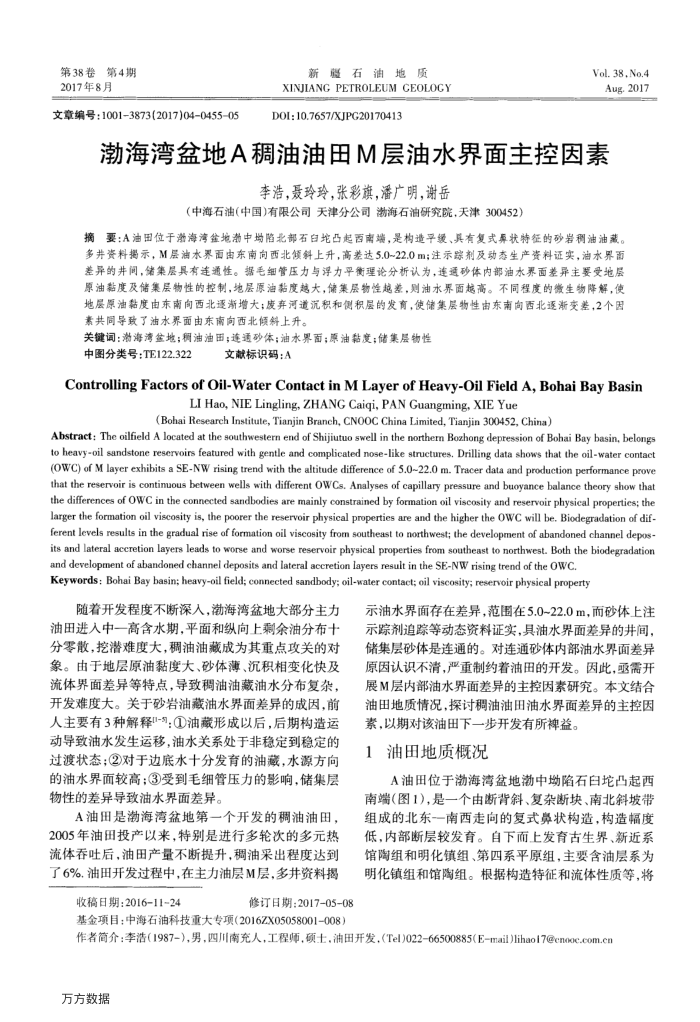您当前的位置:首页>论文资料>渤海湾盆地A稠油油田M层油水界面主控因素
内容简介
 第38卷第4期 2017年8月
第38卷第4期 2017年8月文章编号:1001-3873(2017)04045505
新疆石油地质
XINJIANG PETROLEUM CEOLOGY DOI:10.7657/XJPG20170413
Vol. 38,No.4 Aug. 2017
渤海湾盆地A稠油油田M层油水界面主控因素
李浩,聂玲玲,张彩旗,潘广明,谢岳
(中海石油(中国)有限公司天津分公司渤海石油研究院,天津300452)
摘要:A油田位于潜海湾金地激中墩陷北部石白坨凸起西南填,是构遗平缓、具有复式鼻状特征的砂岩稠油油蔗。多并资料揭示,M层油水界面由东南向西北领斜上升,高差达5.0~22.0m;注示踪剂及动态生产资料证实,油水界面差异的井间,绪集层具有连通性。据毛细管压力与浮力平衡理论分析认为,连适砂体内部油水界面差异主要受地层原油黏度及储集层物性的控制,地层原油粘度越大,储集层物性越差,则油水界西越高。不同程度的缴生物降解,使地层原油黏度由东南向西北逐渐增大;废弃河道沉积和侧积层的发育,使储集层物性由东南向西北逐渐变差,2个因素共同导致了油水界面由东南向西北倾斜上升。
关键词:激海湾盆地;稠油油田;连通砂体;油水界面;原油黏度;储集层物性
中图分类号:TE122.322
文献标识码:A
ControllingFactors of Oil-Water Contact inM Layer ofHeavy-Oil FieldA,Bohai BayBasin
LI Hao, NIE Lingling, ZHANG Caiqi, PAN Guangming, XIE Yue
(Bohai Research Institute, Tianjin Branch, CNOOC China Limited, Tianjin 300452, China)
Abstract: The oilfield A located at the southwestern end of Shijiutuo swell in the northern Bozhong depression of Bohai Bay basin, belongs to heavy-oil sandstone reservoirs featured with gentle and complicated nose-like structures, Drilling data shows that the oil-water contact(OWC) of M layer exhibits a SE-NW rising trend with the altitude difference of 5.0~22.0 m. Tracer data and production performance prove that the reservoir is continuous between wells with different OWCs, Analyses of capillary pressure and buoyance balance theory show that the differences of OWC in the eonnected sandbodies are mainly constrained by formation oil viscosity and reservoir physical properties; the larger the formation oil viscosity is, the poorer the reservoir physical properties are and the higher the OWC will be, Biodegradation of dif-ferent levels results in the gradual rise of formation oil viscosity from southeast to northwest; the development of abandoned channel depos-its and lateral aceretion layers leads to worse and worse reservoir physical properties from southeast to northwest. Both the biodegradation
and development of abandoned channel deposits and lateral aceretion layers resuit in the SE-NW rising trend of the OWC. Keywords: Bohai Bay basin; heavy-oil field; connected sandbody; oil-water contact; oil viscosity; reservoir physical property
随着开发程度不断深入,渤海湾盆地大部分主力油田进入中一高含水期,平面和纵向上剩余油分布十分零散,挖潜难度大,稠油油藏成为其重点攻关的对象。由于地层原油黏度大、砂体薄、沉积相变化快及流体界面差异等特点,导致稠油油藏油水分布复杂,开发难度大。关于砂岩油藏油水界面差异的成因,前人主要有3种解释-5:①油截形成以后,后期构造运动导致油水发生运移,油水关系处于非稳定到稳定的过渡状态;②对于边底水十分发育的油藏,水源方向的油水界面较高:③受到毛细管压力的影响,储集层物性的差异导致油水界面差异。
A油田是渤海湾盆地第一个开发的稠油油田, 2005年油田投产以来,特别是进行多轮次的多元热流体吞吐后,油田产量不断提升,稠油采出程度达到了6%.油由开发过程中,在主力油层M层.多井资料摄
收稿日期:2016-11-24
修订日期:2017-05-08
基金项目:中海石油科技重大专项(2016ZX05058001-008)
示油水界面存在差异,范围在5.0~22.0m,而砂体上注示踪剂追踪等动态资料证实,具油水界面差异的井间,储集层砂体是连通的。对连通砂体内部油水界面差异原因认识不清,严重制约着油田的开发。因此,恶需开展M层内部油水界面差异的主控因素研究。本文结合油田地质情况,探讨稠油油田油水界面差异的主控因素,以期对该油田下一步开发有所神益。
油由地质概况 1
A油田位于渤海湾盆地渤中坳陷石白坨凸起西南端(图1),是一个由断背斜、复杂断块、南北斜坡带组成的北东-一南西走向的复式鼻状构造,构造幅度低,内部断层较发育。自下面上发育古生界、新近系馆陶组和明化镇组、第四系平原组,主要含油层系为明化镇组和馆陶组。根据构造特征和流体性质等,将
作者简介:李浩(1987-),男,四川南充人,工程师,硕土油田开发,(Tel)022-66500885(Email)lihao17@cnooc.com.cn 万方数据